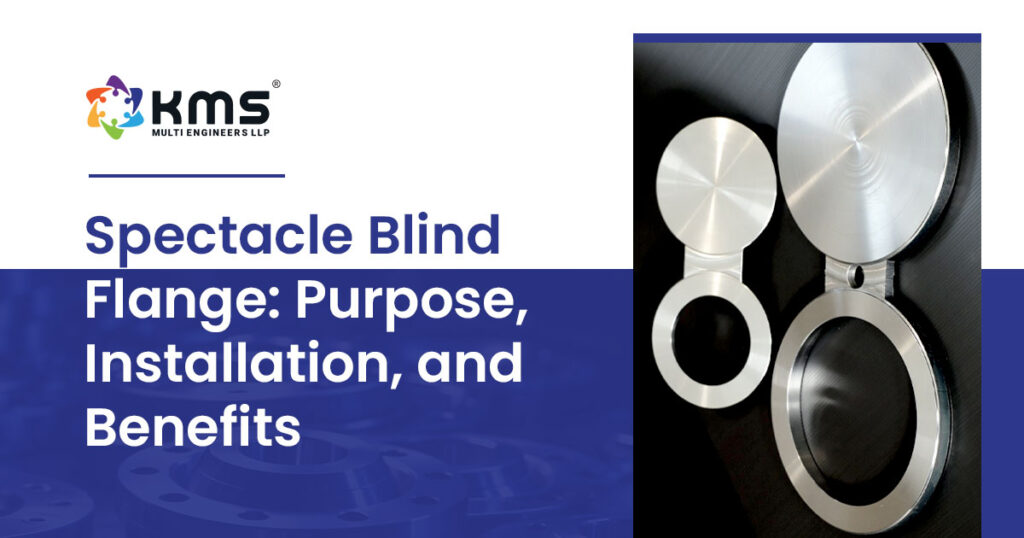In industrial pipeline systems, ensuring safety, controlling flow, and performing maintenance efficiently are top priorities. A key component that supports these objectives is the spectacle blind flange. In this guide, we’ll cover what a spectacle blind flange is, why it’s used, the different types, and key considerations for installation.
What is a Spectacle Blind Flange?
A spectacle blind flange is a safety device used to isolate sections of a pipeline. It consists of two metal plates: one that blocks flow (the “blind” part) and one with a hole allowing flow (the “spacer” part). The two plates are connected like eyeglasses—hence the name “spectacle.” Operators can easily rotate the flange to switch between open and closed states, providing a reliable and simple way to control flow.
Why Use a Spectacle Blind Flange?
Spectacle blind flanges serve a range of important purposes in industrial systems:
- Safety: They provide a visible and dependable way to confirm if a pipeline is isolated, preventing accidents or leaks.
- Maintenance: They simplify maintenance by allowing sections of the pipeline to be shut down for work without affecting the rest of the system.
- Flow Control: Operators can control flow with a simple rotation, adapting the flange position to open or block flow as needed.
By ensuring absolute isolation when required, spectacle blind flanges are essential in high-stakes environments.
Types of Spectacle Blind Flanges
There are several variations of spectacle blind flanges, each designed to meet different requirements:
- Paddle Blind: Similar in function to a spectacle blind but consists of a single plate that blocks flow.
- Spacer: This is the part with a hole that fits into a pipeline to allow normal flow when the spectacle blind flange is rotated into the open position.
- Combination: The most commonly used type combines both the blind and spacer in a single component. This design makes it easy to switch between open and closed positions without removing any parts from the pipeline.
Key Considerations When Choosing a Spectacle Blind Flange
When selecting a spectacle blind flange for your pipeline system, consider the following factors:
- Material: Choose a material compatible with your pipeline contents to prevent corrosion. Common materials include stainless steel, carbon steel, and alloys.
- Size and Pressure Rating: Ensure that the flange’s dimensions match your pipeline and that its pressure rating can withstand operational pressures.
- Installation Space: The flange requires sufficient clearance for rotation, so confirm there is enough space for the device within your setup.
- Maintenance Requirements: For frequent flow control or isolation needs, a spectacle blind flange with an easy-to-rotate design is ideal.
How to Install a Spectacle Blind Flange
Installing a spectacle blind flange is a straightforward process, but it’s essential to follow certain steps for safety:
- Inspect the Flange: Verify that the spectacle blind flange is in good condition, and check that the materials match the system specifications.
- Align with the Gasket: Place the flange carefully, aligning it with the gasket and pipeline flanges.
- Secure Bolts Evenly: Tighten bolts in a cross-pattern to ensure an even and secure seal. This helps prevent leaks and ensures that the flange sits securely.
- Rotate as Needed: Once installed, you can rotate the flange to switch between open and closed positions.
Applications of Spectacle Blind Flanges
Spectacle blind flanges are widely used in industries requiring frequent isolation of pipeline sections:
- Oil and Gas: In refineries and drilling operations, they isolate sections for maintenance or safety purposes.
- Petrochemical Plants: For controlling the flow of hazardous materials, spectacle blind flanges provide a reliable shut-off method.
- Power Generation: They help isolate sections of power plant pipelines for maintenance, especially in high-pressure environments.
- Water Treatment Plants: These flanges prevent cross-contamination during maintenance by isolating specific sections.
Conclusion
Spectacle blind flanges are invaluable for any industrial pipeline system where safety, control, and maintenance are paramount. By providing reliable flow control and isolation, they help operators manage complex systems efficiently and safely. Understanding the types, uses, and proper installation methods can optimize their performance and ensure a secure, leak-free system.
If you’re considering spectacle blind flanges for your operations, consult with industry professionals or suppliers to ensure you select the right type and materials. With the right flange in place, you can enhance your system’s safety, streamline maintenance, and ensure compliance with industry standards.
For More Other Blogs visit https://nciphabr.co.in/






More Stories
Protect Your Property with Expert Roofing Services
The Ultimate Guide to Choosing the Right Fitness Gloves
A Simple Guide to Cauliflower Cultivation in India